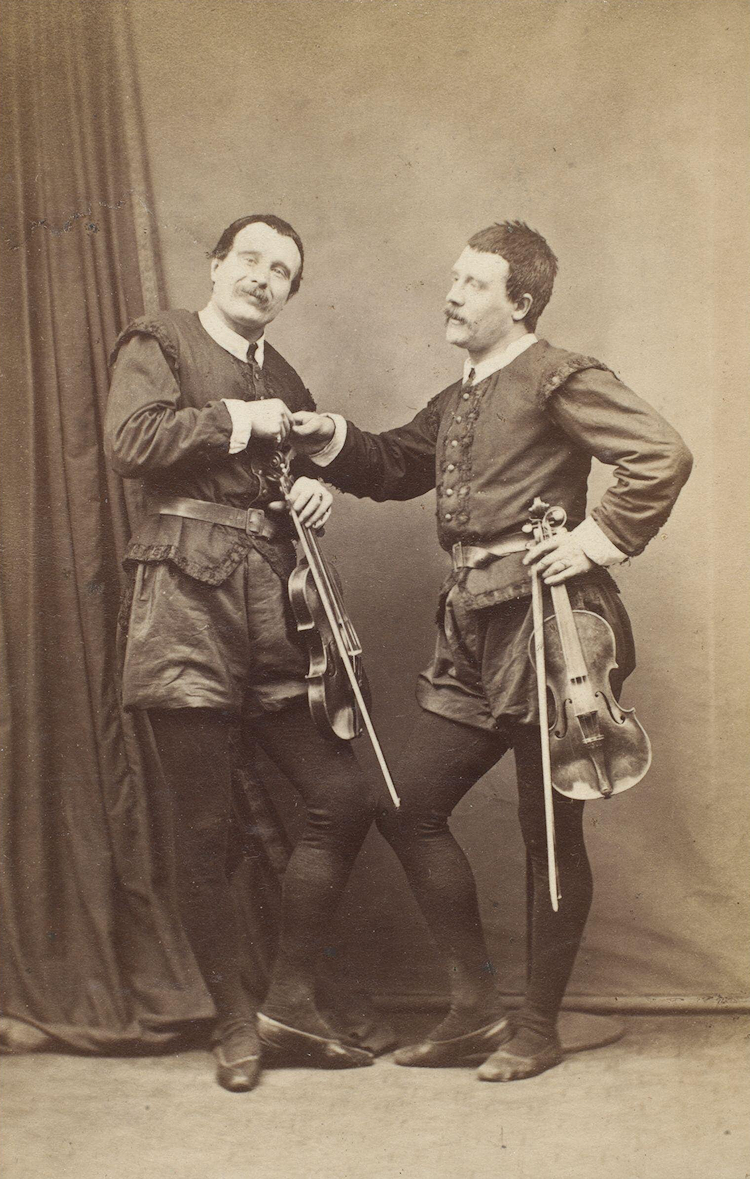
|
| Harry and Fred Payne as, respectively, Clown and Harlequin, their best known roles. |
Harry Payne (25 November 1833 - 27 September 1895) and Frederick Payne (January 1841 - 27 February 1880), brothers, British pantomime entertainers; when performing together, they were billed as The Payne Brothers. They became the chief pantomimists at Covent Garden, known for playing Clown - Harry - and Harlequin - Fred - both roles part of the Harlequinade that followed Victorian pantomimes. Together, the brothers appeared in Gilbert and Sullivan's first collaboration,
Thespis, in 1871; the dancing of the Payne Brothers was so celebrated that W. S. Gilbert referred to it in two of his comic Bab Ballads, "The Bishop of Rum-ti-Foo" and "The Bishop of Rum-ti-Foo Again". When they appeared in the English language version of Offenbach's
The Grand Duchess of Gerolstein, a reviewer in
The Olio wrote, "People go rather to see the eccentric dancing than to hear the eccentric music. However, in justice to the latter, it may be urged that we have all heard enough of the
Grand Duchess, while we are all agreed that we would never see sufficient of the Payne pantomimists - perhaps, taken for all in all, the best in the world."
Their father, William Henry Schofield "W. H." Payne (1804 - 18 December 1878), known as "the King of Pantomime", was an actor, dancer, and classic pantomime artist, who created much of the stage business connected with nineteenth century Harlequinades. Payne's elder son, Harry, began his career mostly in the role of Harlequin but in 1859, while playing a bear at Covent Garden, he had to take over as Clown in the middle of a performance when the actor performing that role collapsed; he would mostly perform as Clown - and to great acclaim - for the rest of his life. Thought by many to be the best clown of his time, Harry Payne died at the age of sixty-two and was buried in Highgate Cemetery.
 |
| Harry Payne in costume as Clown. (Eight images.) |
Harry Payne opened each Boxing Day Harlequinade at Drury Lane with a somersault followed by a cheerful "Here we are again!" And while appearing as Clown at Drury Lane, he was responsible for the creation of one of the biggest Christmas crackers ever made during the Victorian era. It was over seven feet in length and contained a change of costume for the whole cast as well as hundreds of small crackers that the cast threw to the children in the audience.
 |
| Harry Payne in The Grand Duchess [of Gerolstein] at Covent Garden, 1867. (Two images.) |
 |
| Harry Payne out of costume. (Three images.) |
Into the 1870s, the younger brother, Fred, often performed with their father. When he appeared in Drury Lane's
Cinderella in 1865,
The London Review of Politics, Society, Literature, Art & Science said of his performance, "It would be difficult to find anything more truly humorous of its kind, than a combination of a fantastic hornpipe and an equally fantastic minuet, danced by Mr. Frederick Payne...." But he later became best known for his performances with his brother, most often in the role of Harlequin. But in 1877, while engaged in the pantomime at the Alexandra Palace, he became what the newspaper
The Era called mentally "affected". He never fully recovered from this affliction - whatever it actually was - and died three years later at the age of only thirty-nine.
 |
| Fred Payne. |
 |
| Fred Payne as Népomuc in The Grand Duchess [of Gerolstein] at Covent Garden, 1867. (Four images.) |
 |
| As Harlequin. (Two images.) |
*
These images are all in the collection of the Victoria and Albert Museum.






























Glemt som mange store teaterkunstnere i sin tid.
ReplyDelete* OsloSson